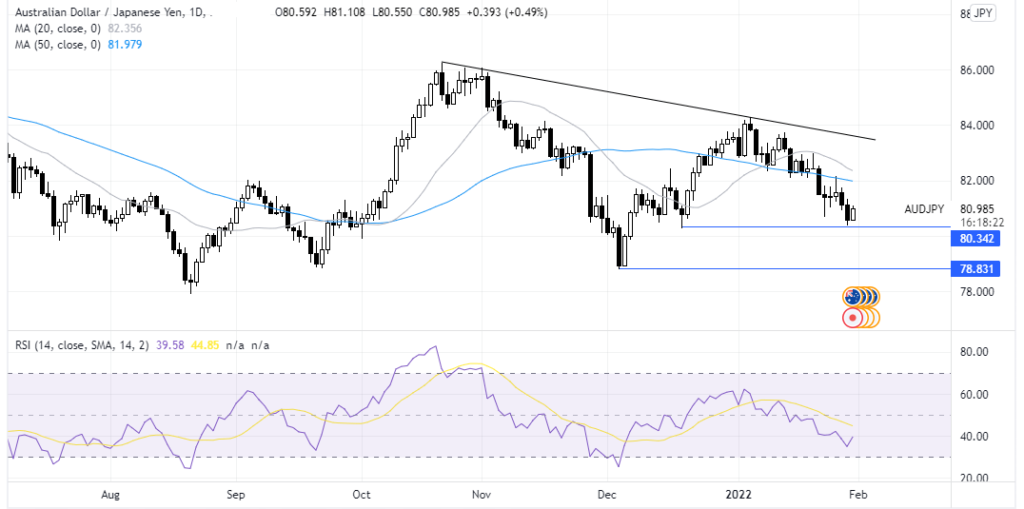DOW Rises as Risk Sentiment Improves, RBA – EU GDP in Focus
AUD/JPY => The pair rises to 81.00
Dow Jones => The index looks towards 35,000
EUR/GBP => The pair rises from 23-month low
AUS Rises on Pre-RBA Optimism
AUD/JPY is on the rise after falling 1.4% lower last week as risk sentiment dropped. Rising geopolitical tensions between Russia and Ukraine, in addition to growing fears that the US economy could struggle to withstand multiple interest rates, rises planned by the Federal Reserve drove risk aversion. Today, the market mood has improved favouring the riskier Aussie, whilst hitting demand for the safe-haven yen. Looking ahead, the RBA interest rate decision is in focus. The RBA is expected to end QE but is not expected to raise interest rates in this meeting. Policymakers are expected to shift towards a more hawkish stance, potentially bringing forward rate hike guidance. At the end of 2021, the RBA was not expecting to raise rates until 2023, although the market expects the RBA to hike around May this year. A more hawkish tone from the RBA could lift the AUD higher.

What’s next for AUD/JPY?
AUD/JPY trades below its falling trendline dating back to early November. It trades below its 50 & 100 sma and the 50 also crossed below the 100 sma in a bearish signal. The RSI is below 50 and supportive of further losses whilst it remains out of the oversold territory. However, the price appears to have found support around 80.30 the December 20 low. A break below here is needed to test 78.78, the December low. Should 80.30 hold, the price could push higher towards 82.00 the 50 sma and last week’s high. A move above here and the 100 sma at 82.38 could see buyers gain momentum.
Dow Jones Industrial Index Set for 4% Monthly Losses
The Dow roared higher on Friday, closing up 1.6%, meaning that the Dow gained 1.3% across last week. This was the first weekly rise for the Dow so far in 2022. The Dow futures are on the rise on Monday but the index is set to drop over 4% across the month of January in one of the worst starts to the year in decades. Whilst concerns over the Fed raising interest rates too fast hit risk sentiment in January, bargain hunters were also out snapping up cheap stocks creating big swings and large bouts of volatility. Despite booking heavy losses, the Dow has outperformed the S&P500 and the Nasdaq thanks to value stocks such as banks which often perform well when interest rate expectations rise.
Euro Rises Ahead of EU GDP, German Inflation
EUR/GBP is on the rise after falling 0.63% across last week. The diverging Central Bank views appear to be one of the main reasons that the pair trades around its lowest level in 23 months. Whilst the BoE is expected to hike interest rates again this week, the ECB is still one of the more dovish major central banks. At the end of last week, softer than expected German GDP data weighed on demand for the euro. The German economy contracted -0.7% QoQ in the final quarter of the year. Today, GDP data from the Eurozone is also expected to show a sharp slowdown in Q4, as Omicron spread across the region and as inflation jumped higher. German inflation figures could also pull on the Euro, if inflation slows as expected.
| Ger. GDP Q4 QoQ
EU GDP Q4 QoQ Ger. Inflation YoY |
Actual: -0.7 (2.4%)
Expected: 0.3% (1.9%) Expected: 4.3% (1%) |
Previous: 1.7%
Previous: 2.2% Previous: 5.3% |
Support can be found at 0.8306 (2022 low) and 0.8280 (Feb 2020 low).
Resistance for the pair can be seen at 0.8365 (January 7 high) and 0.7380 (January 18 high).
Sign up to tixee for Daily Financial Market News & Updates!
